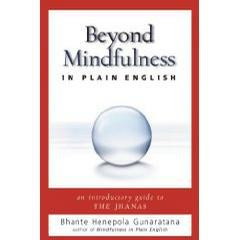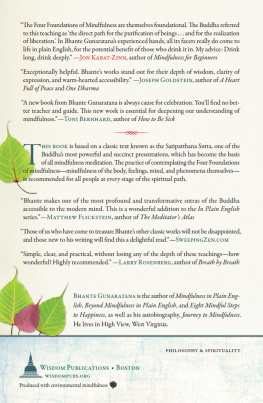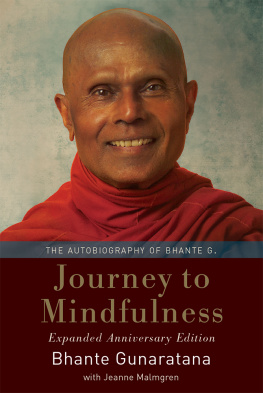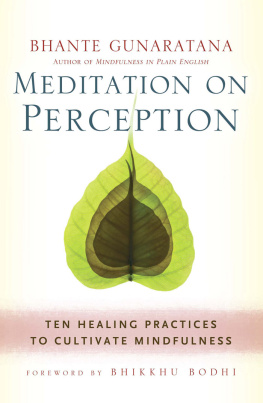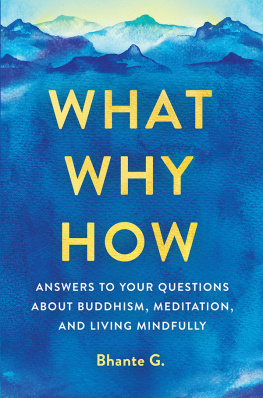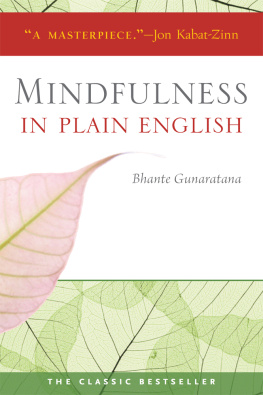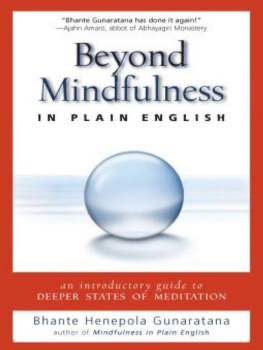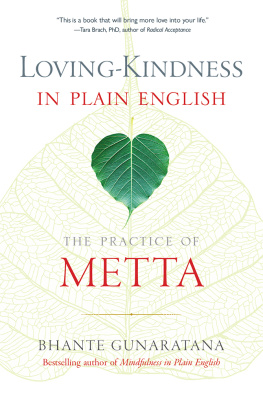Table of Contents

Preface
I N MY EXPERIENCE I have found that the most effective way to express something in order to make others understand is to use the simplest language. I have also learned from teaching that the more rigid the language, the less effective it is. People do not respond to very stern and rigid language, especially when we try to teach something in which people dont normally engage during daily life. Meditation appears to them as something that they cannot always do. As more people turn to meditation, they need more simplified instructions so they can practice by themselves, without a teacher around. This book is the result of requests made by many meditators who need a very simple book written in ordinary language.
In preparing this book I have been helped by many of my friends. I am deeply grateful to all of them. I would especially like to express my deepest appreciation and sincere gratitude to John M. Peddicord, Daniel J. Olmsted, Matthew Flickstein, Carol Flickstein, Patrick Hamilton, Genny Hamilton, Bill Mayne, Bhikkhu Dang Pham Jotika, and Bhikkhu Sona for their most valuable suggestions, comments, and criticisms of numerous points in preparing this book. Elizabeth Reid provided invaluable help in putting together the Afterword to the new edition. Thanks also go to Reverend Sister Sama and Chris OKeefe for their support in production efforts.
Bhante Gunaratana
INTRODUCTION
American Buddhism
T HE SUBJECT OF THIS BOOK is vipassana meditation practice. Repeat, practice. This is a meditation manual, a nuts-and-bolts, step-by-step guide to insight meditation. It is meant to be practical. It is meant for use.
There are already many comprehensive books on Buddhism as a philosophy and on the theoretical aspects of Buddhist meditation. If you are interested in that material, we urge you to read those books. Many of them are excellent. This book, however, is a how to. It is written for those who actually want to meditate, and especially for those who want to start now. There are very few qualified teachers of the Buddhist style of meditation in the United States. It is our intention to give you the basic data you need to get off to a flying start. Only those who follow the instructions given here can say whether we have succeeded or failed. Only those who meditate regularly and diligently can judge our effort. No book can possibly cover every problem that a meditator may run into. You will need to meet a qualified teacher eventually. In the meantime, however, these are the basic ground rules; a full understanding of these pages will take you a very long way.
There are many styles of meditation. Every major religious tradition has some sort of procedure that they call meditation, and the word is often very loosely used. Please understand that this volume deals exclusively with the vipassana style of meditation, as taught and practiced in South and Southeast Asian Buddhism. Vipassana is a Pali-language term often translated as insight meditation, since the purpose of this system is to give the meditator insight into the nature of reality and accurate understanding of how everything works.
Buddhism as a whole is quite different from the theological religions with which Westerners are most familiar. It is a direct entrance to a spiritual or divine realm, without assistance from deities or other agents. Its flavor is intensely clinical, much more akin to what we might call psychology than to what we would usually call religion. Buddhist practice is an ongoing investigation of reality, a microscopic examination of the very process of perception. Its intention is to pick apart the screen of lies and delusions through which we normally view the world, and thus to reveal the face of ultimate reality. Vipassana meditation is an ancient and elegant technique for doing just that.
Theravada (pronounced terra vada) Buddhism presents us with an effective system for exploring the deeper levels of the mind, down to the very root of consciousness itself. It also offers a considerable system of reverence and rituals, in which those techniques are contained. This beautiful tradition is the natural result of its 2,500-year development within the highly traditional cultures of South and Southeast Asia.
In this volume, we will make every effort to separate the ornamental from the fundamental and to present only the plain truth. Those readers who are of a ritual bent may investigate the Theravada practice in other books, and will find there a vast wealth of customs and ceremony, a rich tradition full of beauty and significance. Those of a more pragmatic bent may use just the techniques themselves, applying them within whatever philosophical and emotional context they wish. The practice is the thing.
The distinction between vipassana meditation and other styles of meditation is crucial, and needs to be fully understood. Buddhism addresses two major types of meditation; they are different mental skills or modes of functioning, different qualities of consciousness. In Pali, the original language of Theravada literature, they are called vipassana and samatha .
Vipassana can be translated as insight, a clear awareness of exactly what is happening as it happens. Samatha can be translated as concentration or tranquillity, and is a state in which the mind is focused only on one item, brought to rest, and not allowed to wander. When this is done, a deep calm pervades body and mind, a state of tranquillity that must be experienced to be understood. Most systems of meditation emphasize the samatha component. The meditator focuses his or her mind on a certain item, such as a prayer, a chant, a candle flame, or a religious image, and excludes all other thoughts and perceptions from his or her consciousness. The result is a state of rapture, which lasts until the meditator ends the session of sitting. It is beautiful, delightful, meaningful, and alluring, but only temporary.
Vipassana meditation addresses the other component: insight. The vipassana meditator uses concentration as a tool by which his or her awareness can chip away at the wall of illusion that blocks the living light of reality. It is a gradual process of ever-increasing awareness into the inner workings of reality itself. It takes years, but one day the meditator chisels through that wall and tumbles into the presence of light. The transformation is complete. Its called liberation, and its permanent. Liberation is the goal of all Buddhist systems of practice. But the routes to the attainment of that end are quite diverse.
There are an enormous number of distinct sects within Buddhism. They divide into two broad streams of thought: Mahayana and Theravada. Mahayana Buddhism prevails throughout East Asia, shaping the cultures of China, Korea, Japan, Nepal, Tibet, and Vietnam. The most widely known of the Mahayana systems is Zen, practiced mainly in Japan, Korea, Vietnam, and the United States. The Theravada system of practice prevails in South and Southeast Asia in the countries of Sri Lanka, Thailand, Myanmar, Laos, and Cambodia. This book deals with Theravada practice.
Traditional Theravada literature describes the techniques of both samatha (concentration) and vipassana (insight) meditation. There are forty different subjects of meditation described in the Pali literature. They are recommended as objects of concentration and subjects of investigation leading to insight. But this is a basic manual, and we will limit our discussion to the most fundamental of those recommended objects: breathing. This book is an introduction to the attainment of mindfulness through bare attention to, and clear comprehension of, the whole process of breathing. Using the breath as the primary focus of attention, the meditator applies participatory observation to the entirety of his or her own perceptual universe. The meditator learns to watch changes occurring in all physical experiences, feelings, and perceptions, and learns to study his or her own mental activities and the fluctuations in the character of consciousness itself. All of these changes are occurring perpetually and are present in every moment of our experiences.
Next page
